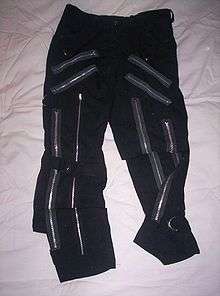Bondage pants

Bondage pants or bondage trousers are trousers with zippers, straps, chains, rings and buckles, giving an appearance of a BDSM style. They come in a variety of colors and patterns; one of the most common patterns being tartan. They also come in a variety of styles, including tight or baggy, long, short or Capri.
They have mainly been worn by members of youth subcultures, including punks, ravers, goths and indies. Although many people consider these pants an element of fetish wear, many early punks have said the origins of the pants were from homeless people who put straps on their pants so they could hold on to a train. They were developed by British designers Vivienne Westwood and Malcolm McLaren in the 1970s punk subculture. The trousers were made infamous by people such as the Sex Pistols, Jordan and Adam Ant who would have to originally get them from Westwood/McClarens shop SEX, later to become Seditionaries, in World's End, Chelsea, London. The original drainpipe design was an anti fashion statement against the flares of the time. The men's variety tend to feature baggier legs, larger pockets and more metal details such as chains, skulls, mock handcuffs and D-rings while the women's styles are usually more tailored and have less metal hardware decoration than the men's styles but occasionally have details of lace, ribbon or tartan making them seem more feminine.
The more popular of the pants seems to be the 'original' black style, with white stitching, although different colored versions including white, hot pink, blue and green have been made with equally varied colors of stitching.
There has been some controversy at certain schools in the United States about the bondage pants being a danger to school property and also for supposed sexual inappropriateness, even to the extent of banning the pants.
See also
References
- Christina Goulding, "Corsets, silk stockings and evening dress: retro shops and retro junkies" in "Time, space, and the market: retroscapes rising" (edd. Stephen Brown, John F. Sherry), M.E. Sharpe, 2003, ISBN 0-7656-1012-4, pp. 54–74
- Tavia Nyong'o, "Do You Want Queer Theory (or Do You Want the Truth)? Intersections of Punk and Queer in the 1970s", Radical History Review 2008(100) pages 103-119 doi:10.1215/01636545-2007-024
- Angela McRobbie, "British fashion design: rag trade or image industry?", Routledge, 1998, ISBN 0-415-05781-7, p. 8
- Andrew Travers, "Ritual Power in Interaction", Symbolic Interaction, Fall 1982, Vol. 5, No. 2, Pages 277–286 doi:10.1525/si.1982.5.2.277